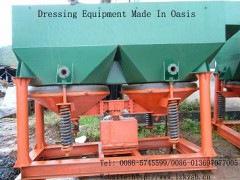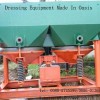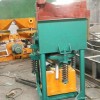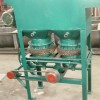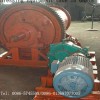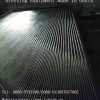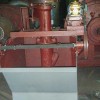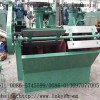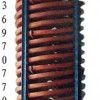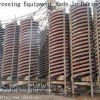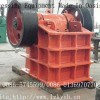JT, jig Gravity Jig
jig beneficiation is one of the main method of gravity separation, process characteristics: continuous ore to be elected to the jig to the room on a sieve to form a thick layer of material. Drum periodically through the sieve into the water rising, rising to a loose bed, then water down (or stop rising). In this process, the relative density of occurrence of different particle transfer heavy minerals into the lower, light mineral into the upper, respectively, have to concentrate and tailings after discharge. This product is the only designated the former Ministry of Geology and Mineral production, the implementation of industry standards.
Sawtooth jig difference: the curve for the sawtooth jig pulse waveform, rising water fast and slow down water flow, the bed was lifted and slow the overall fate of effective loose a long time, can greatly improve the unit's screen surface processing capacity and lower size limit recycling and save a lot of screen under the additional water. With the sine wave of industrial test jig contrast, among the best wave jig gear recovery rate Sn: 3.01%, WO3: 5.5%, Pb: 1.63%, Zn: 2.04%, water consumption reduced 30-75%.
Sawtooth jig beneficiation, apart from very fine material, the size of the deal with almost all kinds of mineral raw materials. Simple process, equipment, processing capacity, and can not get in an election of a final product, therefore, is widely used in production. For metal ores, is dealing with coarse, medium and fine iron ore of the main methods, and is used extensively for sorting tin and tungsten ores; jigging method in dealing with gold, tantalum, niobium, titanium, zirconium, chrome primary ore and gravel sorting can also get good results.
Separation of mineral ores to be greater the density difference, the wider the range of selected Liaoduo for placer gold in the feed particle size is less than 25 mm, you can not grade selected, recovery limit up to 0.05 mm, general metal ores, different levels of selection, can effectively improve the sorting index and increase equipment capacity.
Ore dressing by Gravity Jig is considered as one of the major means for gravity beneficiation with the process characteristics being continued feed of ores to be beneficiated onto screen plate in Jigging Chamber, forming thick material layer. Upward flow is injected via screen plate periodically , allowing the lift of bed layer to be loose and flow to drop (or stop rising). During this process, grains of different densities will displace relatively, with the heavy materials bring delivered into lower layer and the light material being transferred into the upper layer. Concentrate and tailings will be obtained after their being discharged respectively.
Sawtooth-wave Jig is a new type of energy conservation and highly efficient gravity separation equipment and developed based on the traditional Sine Wave Jig. The difference between Sawtooth. Wave Jig and Sine Wave Jig is that the pulsation curve for jigging is of sawtooth wave shape, with speedy upward flow and slow downward flow. Bed layer is elevated integrally and slowly dropped with a long effective loose time, allowing significant increase of handling capacity for unit serene surface, decrease of lower limit of grain size recovery and large save of make-up water for undersize fraction. Industrial tests carried out of Sawtooth Wave Jig and Sine Wave Jig for comparison showed that the recovery rate for operation of Sawtooth Wave Jig is raised by Sn: 3.01%, Pb: 1.63%, Xn: 2.04% with water consumption being decreased by 30-75%.
Ore dressing by Sawtooth Wave Jig is capable of handling almost full sizes of mineral materials other than very fine material. It features simple process operation, heavy duty equipment handling capacity with final products being obtained through one time separation. Therefore, it has found a wide application in production. It is regarded as one of major means to cope with metallic ores such as iron and manganese ores of coarse, moderate and fine sizes and has found significant use in beneficiating tin and tungsten ores. Moreover, Jigging Method also can achieve a good result in processing primary ores bearing gold, tantalum niobium, titanium, zirconium and chrome and sand stones.
More density minerals to be separated in ores have, wider range the feed sizes have. For gold bearing placer, when feed grain size is less than 25 mm, separation may be carried out without size classification with the lower limit of recovery up to 0.05 mm . For ordinary metallic ores, size classified separation is conducted to effectively improve indexes for separation and to enhance handling capability for the equipment .
Model Model | Area | total area Stroke Stroke | red times Times of stroke | feed size Feed Size | ability to deal with Capacity | Power | Overall Overall dimensions | quality Weight | |
m | mm | r / min | mm | t / h | m 3 / h | kw | mm | t | |
JT0.57-1 | 0.57 | 8.5-12 80-180 | < 6 | 1-2.5 1.5 0.05 | 0.6 1150/780/1530 | ||||
JT2-2 | 2.28 | 12-17 | 80-180 | < 10 | 4-8 | 1-3 | 2 | 3220/1550/2050 | 1.6 |
JT3-1 | 3.3 | 80-120 | < 10 | 6-10 | 1-3 | 5.5 | 3180/2000/3030 | 3.26 | |
JT4-2 | 4.33 | 6.5-25 30 10-15 80-120 | < 1-2 | 7.5 | 3600/1850/2600 4.6 | ||||
JT5-2 | 4.86 | 15-25 | 80-120 | < 10 | 10-20 | 1 - 2 | 7.5 | 3600/2000/2600 | 4.8 |
DYTA7750-3 | 9.9 | 20-30 | 0-90 | <25 | 50-75 | 2-5 | 5.5 | 7750/3060/2700 | 6 |
DYTA7750-4 | 20-30 13.2 | 66-100 0-90 | < 25 2-5 | 7750/3060 7.5 / 2700 | 7.5 | ||||
DYTA7750-6 | 19.8 | 20-30 | 0-90 | < 25 | 100-150 | 2-5 | 7.5 | 7750/3060/2700 | 12.5 |
DYTA7750-8 | 26.4 | 20-30 | 0 -90 | < 25 | 132-197 | 2-5 | 11 | 7750/3060/2700 | 16 |
DYTA7750- 29.7 9 | 20-30 0-90 | < 150-220 25 | 11 | 2-5 7750/3060/2700 | 17.5 | ||||
DYTA7750-12 | 39.6 | 20-30 | 0-90 | < 25 | 220 -300 2-5 | 15 | 21 7750/3060/2700 300/450 diaphragm | ||
0-26 2.7 | 320 | 12 | 2-3 3-6 1230/1270/1750 1.1 0.74 | 370 | |||||
/ 360 Diaphragm 2.75 | 5-25 2-5 1-3 | 6 | 1.1 | 2-3 1000/600/1600 0.24 |

